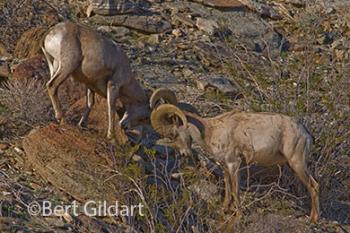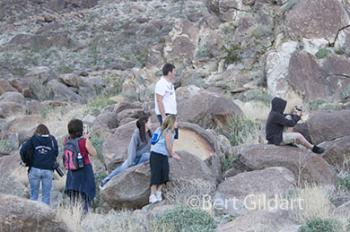Anza Borrego’s Endangered Peninsular Bighorn Sheep

Bighorns spar throughout year
©Bert Gildart: Bighorn sheep don’t normally fight in the winter, but as Janie and I ascended the Palm Canyon Trial in California’s Anza Borrego State Park, we could see two young rams butting horns. The fighting wasn’t intense, but it was persistent, and began moments earlier when one of the two males crashed his head time after time against a large rock. Then, another ram walked into the scene, and Ram Number One turned his attention.
Janie and I had come to this premier park to gather material for a travel story. As well, we wanted to learn more about the Peninsular Bighorn Sheep. Only 280 of this subspecies remain in the United States and 200 find refuge in the park. This was not the first time we had visited Borrego to find sheep, but yesterday was the first time we did, in fact, find them. As a photographer I was delighted by the action of the two rams, knowing, however, that such bouts occur throughout the year, and that often by the time mating season rolls around in the fall, a hierarchy among males has long been established.
Ten years ago Janie and I had visited Anza Borrego, and because I was working on a book about Bighorn Sheep (published by Northword) I had visited with Mark Jorgensen (now the park’s superintendent). At the time he was the park’s terrestrial ecologist and he had related to me a story about just how hard it can be to find bighorns.
SHEEP MIGRATE IMMENSE DISTANCES
Jorgensen said that in 1993 he had found a sick ram in Borrego Springs and that he had captured it and then placed it in a wild animal park to convalesce. Three weeks later, they radio collared the ram and then released it near Montezuma Grade, where it immediately traveled 70 miles. From there the ram traveled 45 miles to In-ko-Pah near the Mexico border, where he stayed for a full year until the next summer’s breeding season.

Collaring reveals sheep still migrate immense distances
“Then,” Jorgensen had explained to me, “Number 270 disappeared.” Using aircraft they eventually found the old ram now another 75 miles away. “Number 270 had crossed five mountain ranges and moved through dozens of canyons.”
The sheep we saw yesterday could have been moving, just as Jorgensen’s Number 270, for sheep are famous for their migrations. Sheep, in fact, were not native to North America, having migrated from Siberia over 10,000 years ago. They are a magnificent animal well known for their social hierarchy, much of which is established by battles that can sometimes be brutal.
HEADS EVOLVED TO WITHSTAND BRUTAL COLLISIONS
Heads and horns of bighorn sheep have evolved to withstand the impact of forceful collisions, and scientists have determined these collisions are substantial. When two rams collide their combined speeds can equal 50 to 70 miles per hour. Multiplying that figure by the weights of the two animals suggests a combined output of 2,400 foot pounds of energy.

Head and horns adapted to withstand immense blows
That’s just one of the “Believe-it-or-Not” type features of this magnificent animal, and we are indeed lucky biologists are working hard to preserve this particular subspecies. In fact, the park now has an ongoing program to help the Peninsular Bighorn. Projects include construction of six water sources in the Vallecito Mountains, fencing of the park boundary to exclude trespassing cattle, the live removal of wild cattle from many of the west side canyons, and removal of exotic trees from desert water holes.
Judging from all the people–to include a local school group–who had assembled on the trail to watch the rams, the biologists’ efforts are much appreciated. Several in the group wondered about the scratch marks on the back of one of the rams, which we all concluded could have been made by a cougar. If that was the case, this ram was indeed lucky.

Students stop to admire the endangered Peninsular bighorn
Janie and I sat along the edge of the trail for over an hour, and before departing, counted 21 rams. They continued to move toward us, and for awhile, we had the group all to ourselves. Every now and then two of the rams would face one another, and occasional butt horns, but soon they moved on.
Because of previous attempts to find this endangered species, we knew we had been fortunate indeed. As Janie likes to say, it’ all because we paid respect in Zion National Park to the sheep images Native Americans had created in the form of their Rock Art .


January 16th, 2009 at 12:25 pm
[...] by rangers who periodically sprinkle scat on the paths. But, then again, writer and photographer, Bert Gildart spotted 21 of the elusive and endangered Peninsular Bighorn Sheep here last year. (Note that all, including myself, are observing sun safety by wearing wide-brimmed [...]